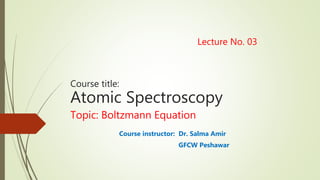
Lecture 03; Boltzmann equation by Dr. Salma Amir
- 1. Lecture No. 03 Course title: Atomic Spectroscopy Topic: Boltzmann Equation Course instructor: Dr. Salma Amir GFCW Peshawar
- 2. How temperature affects atomic spectroscopy Temperature determines the degree to which a sample breaks down into atoms and the extent to which a given atom is found in its ground, excited, or ionized states. Each of these effects influences the strength of the signal we observe.
- 3. Since an atom of a given element gives rise to a definite, characteristic line spectrum, it follows that there are different excitation states associated with different elements. The consequent emission spectra involve not only transitions from excited states to the ground state, e.g. E3 to Eo, E2 to Eo but also transisions such as E3 to E2 , E3 to E1 , etc. (indicated by the broken lines). Thus it follows that the emission spectrum of a given element may be quite complex. In theory it is also possible for absorption of radiation by already excited states to occur, e.g. E1 to E2 , E2 to E3 , etc., but in practice the ratio of excited to ground state atoms is extremely small, and thus the absorption spectrum of a given element is usually only associated with transitions from the ground state to higher energy states and is consequently much simpler in character than the emission spectrum.
- 4. Boltzmann distribution Consider an atom with energy levels E0 and E* separated by ∆E . An atom (or molecule) may have more than one state at a given energy. Figure shows three states at E* and two at E0. The number of states at each energy is called the degeneracy. We will call the degeneracies g0 and g*.
- 5. Boltzmann equation The Boltzmann distribution describes the relative populations of different states at thermal equilibrium. If equilibrium exists (which is not true in the blue cone of a flame but is probably true above the blue cone), the relative population (N*/N0) of any two states is where N* = number of atoms in the excited state, No = number of ground state atoms g*/go = ratio of statistical weights for ground and excited states ∆E = energy of excitation = hv, T = temperature (K) and k = Boltzmann’s constant (1.381 x10-23 J/K). 𝑵∗ 𝑵𝟎 = ( 𝒈∗ 𝒈𝟎 )𝒆−∆𝑬/𝒌𝑻
- 6. Effect of Temperature on Excited-State Population The lowest excited state of a sodium atom lies 3.371x 1019 J/atom above the ground state. The degeneracy of the excited state is 2, whereas that of the ground state is 1. The fraction of Na in the excited state in an acetylene-air flame at 2 600 K is, 𝑵∗ 𝑵𝟎 = ( 𝟐 𝟏 )𝒆 −(𝟑.𝟑𝟕𝟏×𝟏𝟎−𝟏𝟗 𝑱 [(𝟏.𝟑𝟖𝟏 × 𝟏𝟎−𝟐𝟑 𝑱 𝑲) (𝟐𝟔𝟎𝟎𝑲)] = 1.67x 10-4 That is, less than 0.02% of the atoms are in the excited state. If the temperature were 2 610 K, the fraction of atoms in the excited state would be 𝑵∗ 𝑵𝟎 = ( 𝟐 𝟏 )𝒆 −(𝟑.𝟑𝟕𝟏×𝟏𝟎−𝟏𝟗 𝑱 [(𝟏.𝟑𝟖𝟏 × 𝟏𝟎−𝟐𝟑 𝑱 𝑲) (𝟐𝟔𝟏𝟎𝑲)] = 1.7 x 10-4 The fraction of atoms in the excited state is still less than 0.02%, but that fraction has increased by 100(1.74 - 1.67)/1.67 = 4%. A 10-K temperature rise changes the excited state population by 4% in this example.
- 7. The Effect of Temperature on Absorption and Emission We see that more than 99.98% of the sodium atoms are in their ground state at 2 600 K. Varying the temperature by 10 K hardly affects the ground-state population and would not noticeably affect the signal in atomic absorption. How would emission intensity be affected by a 10 K rise in temperature? absorption arises from ground-state atoms, but emission arises from excited-state atoms. Emission intensity is proportional to the population of the excited state. Because the excited state population changes by 4% when the temperature rises 10 K, emission intensity rises by 4%. It is critical in atomic emission spectroscopy that the flame be very stable, or emission intensity will vary significantly. In atomic absorption spectroscopy, temperature variation is important but not as critical. Almost all atomic emission is carried out with an inductively coupled plasma, whose temperature is more stable than that of a flame. Plasma is normally used for emission, not absorption, because it is so hot that there is a substantial population of excited-state atoms and ions.